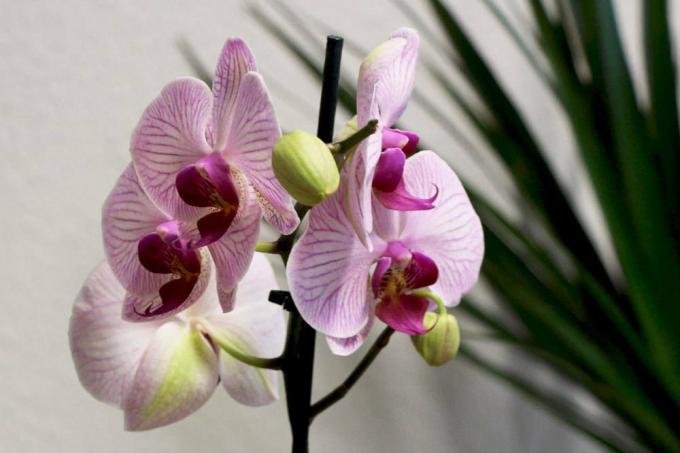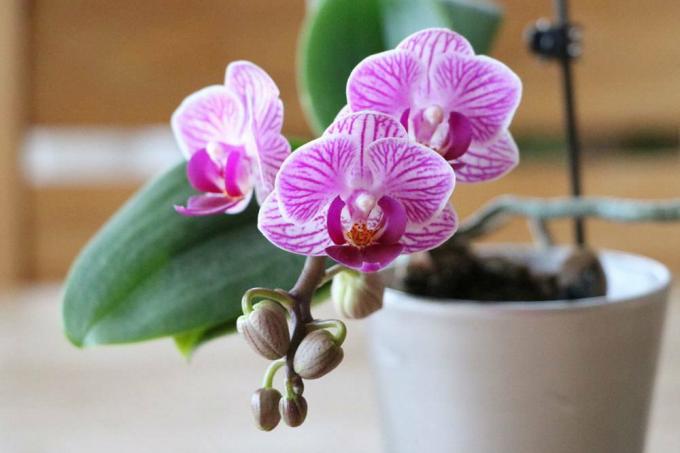
table of contents
- Rotten orchid
- Heart rot
- causes
- Damage image
- Combat
- prevention
- Stem rot
- causes
- Damage image
- Combat
- prevention
Even experienced orchid lovers often only realize that the orchid is rotting when help comes too late. Diseases like the heart or the stem rot turn out to be treacherous as a seemingly healthy plant suddenly dies. Read about the signs to look out for in your orchids and how to treat affected specimens. However, since putrefaction almost always leads to death, preventive measures are still the best treatment.
Rotten orchid
If the orchid gets soft or even rotten spots, it is usually due to one of the two putrefactive diseases:
- Heart rot
- Stem rot
We will show you how you can recognize the two types of damage and what you can do against the diseases.
Heart rot
Heart rot is a typical phenomenon of monopodial growing Orchidaceae such as the popular one Phalaenopsis (Butterfly orchid) or the equally uncomplicated Vanda. These two species form a single plant sprout, from the center of which new leaves sprout alternately.
causes
Putrefactive diseases are always triggered by excessive moisture, which in turn triggers the colonization of fungi or bacteria and the corresponding decomposition processes. These can be different pathogens, only the symptoms and consequences of the disease are the same. If the heart of the orchid begins to rot, there is often stagnant water between two leaves or between a leaf and the bulb is the cause. From here the moisture gets inside, into the "heart" of the plant. This is where the usually bacterial pathogens find the best growth conditions and multiply within a short time - the orchid rots from the inside out.
In addition to incorrect watering, these causes can also lead to excess moisture and thus to an outbreak of heart putrefaction:
- too high humidity
- wrong / too frequent Dive or spray
- Condensation water, orchids cannot "dry off" in between
- Pouring, dipping or spraying at the wrong time, e.g. B. in the evening
- little fresh air, e.g. B. in the terrarium
Damage image
Characteristic of the disease is the sudden fall of apparently healthy leaves, which detach from the plant with the slightest touch. Often the upper, i.e. the youngest, leaves color first yellow, whereby on closer inspection not only the lower, sometimes still green, leaves also say goodbye, but also the cause of the evil can be recognized. The areas affected by the heart rot are
- colored black,
- wet,
- soft to mushy,
- smelling of putrefaction.
If the disease is not very advanced, only one or a few places are affected. However, the more time the pathogens have for their work, the more the rot spreads to other parts of the orchid - until it is finally completely rotten. The trunk can also be affected.
Combat
Heart rot almost always leads to the death of the orchid, treatment is usually only possible at the very beginning of the disease. If only one or more small areas are affected and the roots are still healthy, you can try the following measures:
- Cut away diseased parts of the plant generously
- Disinfect interfaces
- dust with coal or fresh cinnamon powder
- Keep the plant dry
In most cases, however, the rot is not recognized until it has penetrated deep into the heart of the plant. Now the orchid no longer forms any new leaves and sooner or later dies. The plant can no longer be saved and must be disposed of. However, do not throw them on the compost, but throw them in the trash. The plant pot must also be thoroughly cleaned and disinfected before it can be used again. Otherwise there is a risk of new plants being infected, as the pathogen remains on the surface and does not die with the plant.
tip: With a little luck, however, so-called Regular childthat you can separate and plant as genetically identical offspring. To do this, continue to care for the affected orchid as usual, although you should separate it from other plants. This prevents the pathogens from spreading to previously healthy specimens.
prevention
As always, prevention is the best medicine, so here are some tips to keep in mind when caring for Orchidaceae:
- Water in the morning to allow water to dry off over the course of the day
- Do not water in the evening or at night because of poor evaporation
- Avoid high humidity in closed rooms
- ventilate regularly
- no water on or let stand in the orchid
- do not pour over the leaves / from above
- Water between leaves or Dab leaves and bulbs with paper or cotton wool
Stem rot
The stem rot is quite similar to the heart rot described above. Here, too, mainly species such as Phalaenopsis or Vanda are affected, which only develop a plant sprout and let their leaves sprout one after the other from its center. This disease is just as dangerous as the affected plant almost always dies. However, there are some differences with regard to the damage and the causes - and thus, of course, treatment and preventive measures.
causes
The root rot is mostly caused by a substrate that is too moist, whereby an advanced heart rot can also develop into a stem rot. Here, too, there is an excess of moisture or even wetness behind the disease, which ultimately leads to a strong multiplication of mostly bacterial pathogens. In addition, other causes lead to the typical damage:
- constantly moist, in between hardly drying substrate
- excess irrigation water is in the cachepot
- Plant is potted too deep
- Trunk stays wet for too long after spraying, does not dry off
- Plant does not dry off after dipping
tip: In many places, experienced orchid keepers recommend not to water the plants, but to immerse them. After that, however, you need to drain them well so that excess water does not collect in the pot.
Damage image
While with heart rot the youngest leaf - the so-called heart leaf of the orchid - rots first, with stem rot the lower leaves first turn yellow and then fall off. Here, too, in the case of advanced rot, all of the leaves can suddenly be thrown off at once, even if the plant is gently touched. Putrid spots are black, soft and damp, especially the trunk, the inside, the plant.
Combat
Putrefactive diseases are treacherous because they are often recognized very late and therefore in almost all cases end with the death of the affected orchids. Stem rot is no exception, because as soon as the inside of the plant rots and all leaves are shed, it will no longer sprout a new heart leaf. However, you do not need to hand the specimen in question to the organic waste bin immediately, because if the roots still appear healthy, offshoots often form, the so-called Regular child, the end. Dust the putrid spots with powdered charcoal or fresh cinnamon powder, place the plant in fresh, dry substrate, and wait a while. After a few weeks or months, with a little luck, you will have a healthy, genetically identical offspring.
prevention
Since the treatment of rotting Orchidaceae is hardly successful, preventive measures are even more important. These hints are particularly useful:
- do not pour from above, but always onto the substrate
- Always remove excess irrigation water promptly
- Leave out the cachepot, this prevents the moisture from evaporating
- Keep orchids drier in winter
- Water less and, above all, less, as moisture only evaporates slowly

tip: If the putrefaction is still in its early stages, quick help in the form of saves Repot the plant in question sometimes in fresh, dry substrate. Charcoal or cinnamon powder disinfects the putrid spots and prevents them from spreading further.




